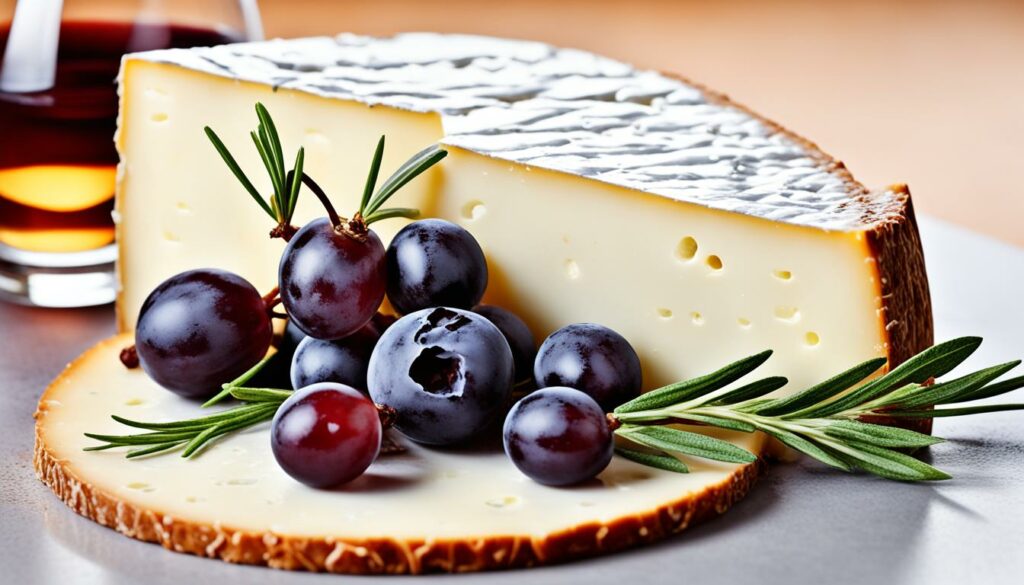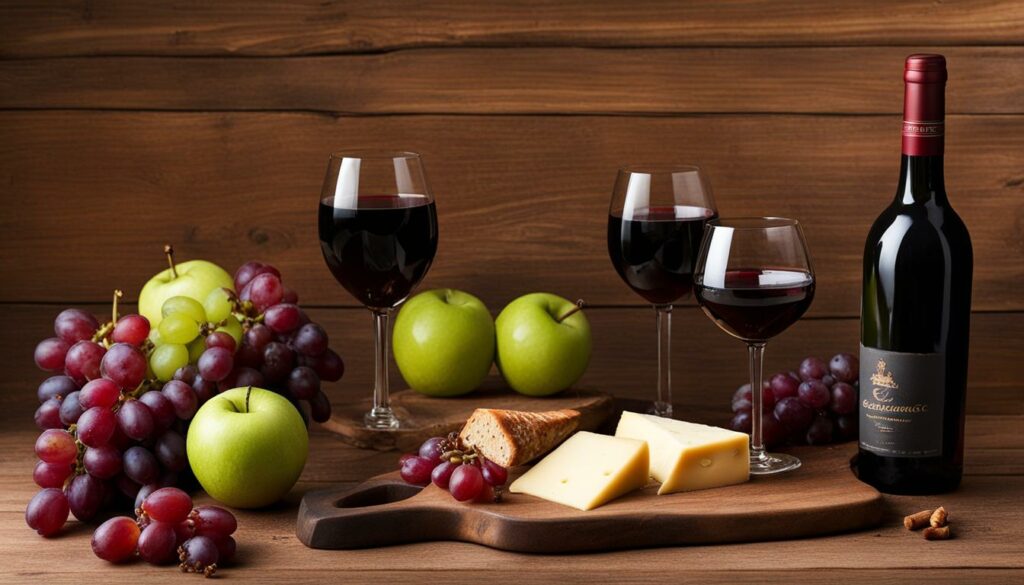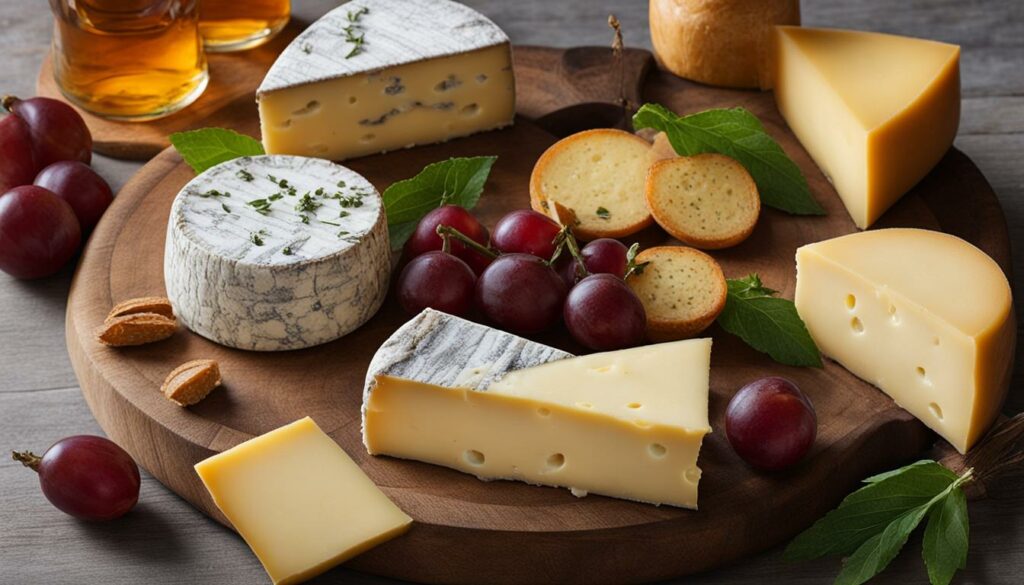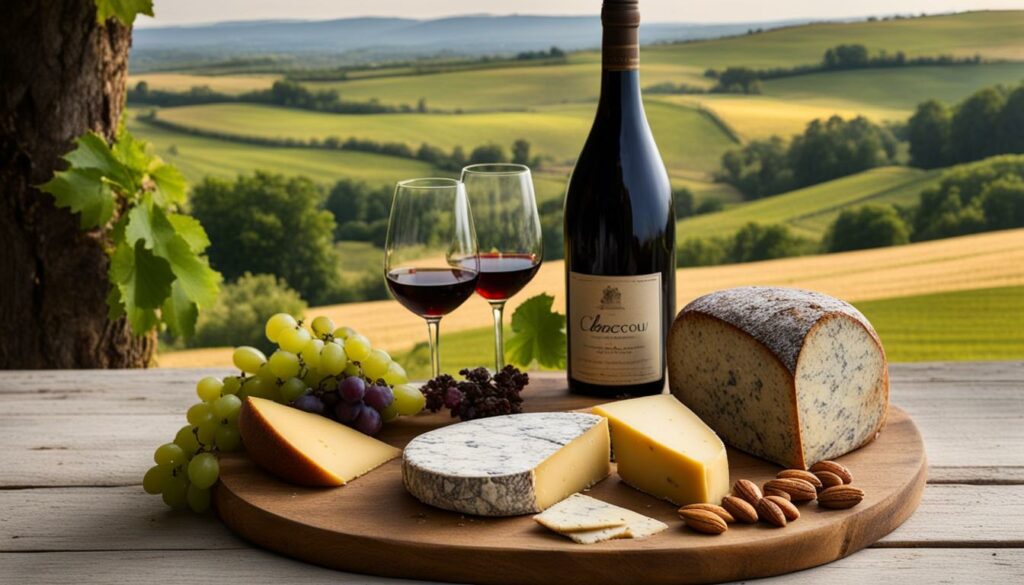Welcome to our guide to Cabecou Feuille D’Armagnac cheese, an artisanal French cheese that is bound to delight your taste buds. If you are a fan of gourmet cheeses, particularly those with a rich tradition and authentic flavors, then Cabecou Feuille D’Armagnac will surely satisfy your cravings. This specialty cheese hails from the Armagnac region of France, known for its unique and exceptional culinary offerings.
What sets Cabecou Feuille D’Armagnac apart is its infusion of Armagnac, a distinctive brandy from the region. This infusion adds an aromatic depth and complexity to the cheese, making it truly one-of-a-kind. The cheese is also sprinkled with black pepper, which adds a subtle spiciness to the flavor profile. To complete the masterpiece, Cabecou Feuille D’Armagnac is delicately wrapped in chestnut leaves, providing a visually stunning presentation.
If you are a cheese enthusiast looking for something unique and exquisite, Cabecou Feuille D’Armagnac is the perfect choice. Its artisanal craftsmanship and traditional production methods ensure that every bite is a true culinary experience. Whether enjoyed on its own or paired with complementary accompaniments, Cabecou Feuille D’Armagnac cheese is sure to dazzle your palate and transport you to the beautiful landscapes of southwestern France.
The Origin and Production of Cabecou Feuille D’Armagnac Cheese
Welcome to the world of Cabecou Feuille D’Armagnac cheese! This exquisite French goat’s cheese hails from the picturesque Perigord region in south-western France. Made with love and expertise, this fresh cheese is a testament to the rich culinary traditions of the area.
Made from the finest fresh goat’s milk, Cabecou Feuille D’Armagnac is transformed into a culinary masterpiece through a meticulous production process. The cheese is carefully infused with the flavors of plum brandy, creating a harmonious blend of creamy richness and aromatic sweetness. Afterward, a sprinkle of black pepper adds a touch of mild spiciness, perfectly balancing the flavors.
To enhance the cheese’s taste and appearance, Cabecou Feuille D’Armagnac is delicately wrapped in chestnut leaves. Not only do these leaves impart a subtle earthy flavor, but they also contribute to the cheese’s elegant presentation. The result is a cheese that is both visually striking and a delight to the taste buds.

The Art of Cheese Making
The production of Cabecou Feuille D’Armagnac cheese is a labor of love, combining traditional techniques with artisanal craftsmanship. The local cheese makers in Perigord take pride in their heritage and expertise, ensuring that each batch of cheese is of the highest quality.
Through the skilled hands of these cheesemakers, Cabecou Feuille D’Armagnac cheese has become a celebrated delicacy, cherished both in France and around the world. Its distinctive flavor profile, influenced by the infusion of plum brandy and the use of chestnut leaves, sets it apart from other cheeses in the market.
| Key Features | Description |
|---|---|
| Origin | Perigord, south-western France |
| Type of Cheese | French goat’s cheese |
| Main Ingredients | Fresh goat’s milk, plum brandy, black pepper, chestnut leaves |
| Flavor Profile | Aromatic, creamy, with hints of plum brandy and a mild spiciness |
| Texture | Soft, smooth, and velvety |
Experience the divine flavors of Cabecou Feuille D’Armagnac cheese, a true gem from the Perigord region. Whether enjoyed on a cheese board, paired with a fine wine, or incorporated into your favorite dishes, this unique cheese is sure to tantalize your taste buds.
The Taste and Texture of Cabecou Feuille D’Armagnac Cheese
The flavor of Cabecou Feuille D’Armagnac cheese is truly unique. This artisanal French cheese undergoes a special infusion of Armagnac, a type of brandy, which imparts a rich and fruity taste. The Armagnac flavors blend harmoniously with the slight spiciness of black pepper, creating a delightful sensory experience.
However, it’s not just the flavor that makes Cabecou Feuille D’Armagnac cheese exceptional. The cheese itself has a soft and creamy texture, typical of goat’s cheese. This velvety smoothness enhances the overall enjoyment, allowing the flavors to melt on your palate.
When you take a bite of Cabecou Feuille D’Armagnac cheese, you’ll experience a perfect balance of aromatic brandy flavors and the luscious creaminess of goat’s cheese. It’s a true indulgence for cheese lovers and a testament to the skill and craftsmanship of French cheese makers.

Pairing Cabecou Feuille D’Armagnac Cheese with Wine and Accompaniments
When it comes to enjoying the delightful flavors of Cabecou Feuille D’Armagnac cheese, finding the perfect pairing can elevate your tasting experience. Whether you’re hosting a dinner party, enjoying a cozy evening at home, or simply indulging in a moment of culinary appreciation, selecting the right wine and accompaniments can enhance the flavors and textures of this exquisite French cheese.

Wine Pairing
Cabecou Feuille D’Armagnac cheese has a unique flavor profile that calls for a wine pairing that complements its delicate and aromatic qualities. A fruity wine, such as a Pinot Noir, offers a harmonious balance of flavors when enjoyed alongside this artisanal French cheese. The fruity undertones of the wine enhance the rich and complex taste of the cheese, creating a delightful harmony on your palate.
Accompaniments
To further enhance the flavors of Cabecou Feuille D’Armagnac cheese, consider serving it with a selection of accompaniments. Slices of fresh bread or crispy crackers provide a satisfying crunch that contrasts with the smooth and creamy texture of the cheese. Additionally, dried fruits like figs or dates add a touch of sweetness that complements the savory notes of the cheese.
Create a visually appealing cheese board by arranging the Cabecou Feuille D’Armagnac cheese, wine, bread, crackers, and dried fruits together. The combination of these elements creates a symphony of flavors and textures, offering a taste sensation that will impress your guests or simply elevate your personal cheese-tasting experience.
If you prefer a more guided experience, consider the following table for inspiration:
| Wine | Accompaniments |
|---|---|
| Pinot Noir | Fresh bread, crackers, dried figs, and dates |
| Sauvignon Blanc | Baguette slices, grapes, and toasted almonds |
| Gamay | Walnut bread, apple slices, and cranberry compote |
Experiment with different wine and accompaniment pairings to find your favorite combination. The possibilities are endless, and each variation offers a unique blend of flavors and textures that perfectly complement the Cabecou Feuille D’Armagnac cheese.
The Art of Cheese Making in France
French cheese making is a true art form, steeped in centuries-old traditions and a deep commitment to craftsmanship. When it comes to creating exceptional cheeses, the French are renowned for their expertise and attention to detail. This dedication to quality is evident in cheeses like Cabecou Feuille D’Armagnac, which exemplifies the traditional cheese making techniques of France.
The process of crafting French cheeses involves meticulous care at every step, starting with the selection of the finest ingredients. In the case of Cabecou Feuille D’Armagnac, fresh goat’s milk is used, sourced from local farms in the Perigord region of southwest France.
Next comes the art of transforming milk into cheese. Skilled cheese makers use traditional methods, including hand ladling and slow coagulation, to ensure the highest quality and optimal flavors. This artisanal approach contributes to preserving the distinct characteristics and flavors that set French cheeses apart.
As the cheese matures, it undergoes a process that may span several weeks or even months, depending on the variety. During this time, cheese artisans carefully monitor and turn the cheeses, allowing the flavors to develop and the textures to become perfectly balanced. The result is a cheese like Cabecou Feuille D’Armagnac, with its delightful combination of creamy softness and intricate flavors.
To add another layer of uniqueness, Cabecou Feuille D’Armagnac is artfully wrapped in chestnut leaves. This not only gives the cheese a visually striking appearance, but also imparts subtle earthy notes that enhance its overall taste. This attention to detail is a testament to the cheese craftsmanship that has been perfected over generations in France.
French cheese making is not merely a process; it is an art form that showcases the rich history and culinary expertise of the country. Each step, from milking the goats to wrapping the cheese in leaves, is performed with precision and passion, resulting in exceptional cheeses that captivate the senses.

Whether enjoyed on its own or paired with wine and other accompaniments, French cheeses like Cabecou Feuille D’Armagnac are a true testament to the artistry and dedication of cheese makers in France. Their commitment to traditional cheese making techniques and unwavering pursuit of excellence make French cheeses a delight for cheese connoisseurs worldwide.
Exploring the World of French Cheeses
France is renowned for its rich and diverse cheese culture, boasting over 350 distinct types of cheeses. From soft and creamy Camembert to firm and nutty Abondance, French cheeses offer an enticing variety of flavors, textures, and aromas. These cheeses are classified into eight cheese families, each with its own unique characteristics and production methods.
Here is a glimpse into the different cheese families and the delightful variety of French cheeses they encompass:
French Cheese Families
1. Fresh Cheeses:
These cheeses are consumed within a few days of production and are known for their mild and tangy flavors. They include the popular and versatile goat cheese, Chèvre, as well as the creamy Fromage Blanc.
2. Soft-Ripened Cheeses:
These cheeses develop a soft and creamy texture as they mature, a result of the mold that grows on their rind. Camembert and Brie, the world-famous creamy delights, belong to this family.
3. Pressed Cheeses:
Also known as semihard cheeses, pressed cheeses undergo a process in which whey is removed from the curds. Examples include the mild and slightly nutty Emmental and Comté, as well as the fruity and savory Beaufort.
4. Blue Cheeses:
These distinct cheeses are characterized by the blue veins that run throughout their interior. The renowned Roquefort and creamy Bleu d’Auvergne are prominent members of this family.
5. Cooked or Hard Cheeses:
These cheeses undergo a lengthy aging process, resulting in a hard texture and intense flavors. The popular Gruyère, with its nutty and earthy profile, and the sharp and salty Parmesan fall into this category.
6. Goat and Sheep’s Milk Cheeses:
French cheeses made from goat or sheep’s milk offer a unique taste and texture. These cheeses include the creamy and delicate Chabichou du Poitou and the rich and buttery Ossau-Iraty.
7. Washed-Rind Cheeses:
These cheeses are bathed in brine or alcohol during the aging process, creating a distinctive aroma and flavor. The pungent and meaty Époisses and the creamy and bold Munster are renowned examples.
8. Melted Cheeses:
This family includes cheeses that are specifically crafted for melting, resulting in gooey and savory delights. The beloved Reblochon, ideal for the classic French dish Tartiflette, is a prominent member of this family.
In France, cheese production is classified into four categories, each contributing to the diverse cheese landscape:
Cheese Production Categories in France
| Category | Description |
|---|---|
| Fermier (Farmhouse Cheese) | Produced on the farm using milk from the farmer’s own animals. |
| Artisanal (Small-Scale Producers) | Made by small-scale producers who follow traditional methods and craft each cheese with care and expertise. |
| Coopérative (Dairy Cooperatives) | Produced collaboratively by farmers who pool their resources and milk to create a range of high-quality cheeses. |
| Industriel (Factory-Made Cheese) | Manufactured on a larger scale in factories, often using modern production techniques. |
This classification system ensures that consumers have access to a wide range of French cheeses, each with its own story, craftsmanship, and unique flavors.

Protected Designation of Origin for French Cheeses
When it comes to French cheeses, authenticity and quality are paramount. That’s why many renowned French cheeses, including Cabecou Feuille D’Armagnac, are protected by designations of origin such as AOC (Appellation d’Origine Contrôlée) and PDO (Protected Designation of Origin). These designations ensure that the cheese is produced according to strict regulations and guidelines, preserving its traditional production methods and safeguarding its unique characteristics.
The AOC system, established in 1935, is a French certification that guarantees the geographical origin and traditional manufacturing methods of various products, including cheeses. This system is responsible for ensuring that certain regional cheeses are made in specific areas and using specific techniques, thus preserving their distinct qualities.
Similarly, the PDO designation, recognized by the European Union, serves to protect the geographical origin and traditional craftsmanship of a product. This designation establishes a link between the product and its place of origin, ensuring that it is made in accordance with established standards and can only bear the PDO label if produced within the designated region.
“PDO and AOC designations are essential in preserving the integrity and heritage of French cheeses. They provide consumers with the assurance that the cheese they are enjoying is of the highest quality and adheres to the strict regulations put in place to protect its unique characteristics.”
These protection systems also exist in other European countries, such as the Italian DOC system and the Spanish Denominación de origen system. By affording these cheeses legal protection, these designations ensure that the rich diversity and cultural significance of European cheeses are preserved for generations to come.
As a lover of French cheeses, you can trust that cheeses bearing the PDO or AOC label have met the rigorous standards set forth by these protection systems. So, whether you’re indulging in Cabecou Feuille D’Armagnac or any other French cheese, you can savor each bite knowing that it represents the true essence of its regional heritage.
The Benefits of PDO and AOC Designations for French Cheeses
The PDO and AOC designations offer several benefits for both producers and consumers:
- Guaranteed quality: The designations ensure that the cheese is produced using traditional methods and adheres to strict quality standards.
- Authenticity: The designations link the cheese to its specific region of origin, preserving its unique flavor and character.
- Consumer confidence: The labels provide consumers with the assurance that they are purchasing a genuine and high-quality French cheese.
- Support for local economies: By protecting traditional production methods, these designations contribute to the economic sustainability of cheese-producing regions.
French cheeses with PDO and AOC designations are truly a testament to the country’s rich cheese-making heritage and the commitment to preserving its unique flavors and traditions.
The French Cheese Culture and Appreciation
Cheese holds a special place in French culture, with a long-standing tradition of cheese consumption and appreciation. French people take great pride in their cheese-making heritage and enjoy a wide variety of cheese types in their daily lives. Cheese is often served as a separate course during meals or enjoyed alongside bread and wine. The rich flavors and textures of French cheeses are celebrated and cherished by cheese connoisseurs worldwide.
French cheese culture is deeply rooted in history, dating back centuries. The art of cheese making has been passed down through generations, resulting in a wide array of unique and exquisite cheeses. From creamy Brie to pungent Roquefort, each cheese carries its own story and essence, reflecting the traditions and expertise of its region.

French cheese consumption is a daily ritual for many. Whether enjoyed as a snack, incorporated into recipes, or enjoyed as a centerpiece on a cheese platter, cheese holds an esteemed position in French gastronomy.
To truly appreciate French cheese, one must understand the art of cheese pairing. French cuisine places a strong emphasis on balance and harmony, and the same principle applies to cheese. Pairing cheese with the right accompaniments, such as bread, fruit, and wine, enhances the overall taste experience and allows for the subtle nuances of the cheese to shine.
Cheese Traditions and Regional Specialties
France is home to numerous cheese regions, each with its specialty and unique cheese traditions. From Normandy’s Camembert to Auvergne’s Cantal, each region has its distinctive cheese-making techniques and flavor profiles.
Here is a glimpse into some of the most renowned cheese regions in France:
| Region | Notable Cheeses |
|---|---|
| Normandy | Camembert, Pont-l’Évêque, Livarot |
| Alsace | Munster, Géromé |
| Savoie | Abondance, Beaufort, Reblochon |
| Provence | Banon, Pélardon |
| Auvergne | Fourme d’Ambert, Saint-Nectaire, Salers |
These regional cheeses are a testament to the diversity and richness of French cheese culture. Each cheese represents the unique terroir of its region, influenced by factors such as soil, climate, and local traditions.
The French take great pride in their cheese, upholding age-old traditions and embracing the true essence of terroir. From the lush pastures of Normandy to the mountainous regions of Savoie, each cheese tells a story, capturing the essence of its origin.
French Cheese Appreciation Worldwide
French cheese appreciation extends far beyond its borders. The rich flavors, exquisite textures, and unparalleled craftsmanship of French cheeses have captivated cheese lovers worldwide.
French cheeses are often featured in international cheese competitions and are highly sought after by connoisseurs and chefs around the globe. The influence of French cheese can be seen in fine dining establishments, artisanal cheese shops, and even home kitchens, where enthusiasts strive to recreate the flavors and experiences of France.
French cheese culture has become an inspiration for cheese-making traditions in other countries, leading to the development of unique and exceptional cheeses that pay homage to the French craftsmanship.
Explore the world of French cheeses and embark on a culinary journey that celebrates centuries of cheese-making expertise, regional specialties, and the sheer joy of savoring the finest cheese creations.
Exploring Other French Cheeses
In addition to Cabecou Feuille D’Armagnac, there are many other popular and unique French cheeses to explore. France is renowned for its rich cheese culture and offers a vast array of cheese varieties to tantalize your taste buds.
- Brie de Meaux: With its creamy texture and mild, buttery flavor, Brie de Meaux is a beloved choice among cheese connoisseurs.
- Camembert: This creamy and aromatic cheese, with its bloomy rind and soft interior, is widely enjoyed both in France and around the world.
- Roquefort: Known as the “King of Cheeses,” Roquefort is a famous blue cheese made from sheep’s milk and aged in natural caves, resulting in a distinctive tangy flavor.
- Comté: This firm and nutty cheese is produced in the Jura Mountains of France and offers a rich and complex flavor profile.
These are just a few examples of the variety of French cheeses available. Each cheese has its own unique characteristics, ranging from creamy and mild to bold and sharp, ensuring there is something to suit every palate.
Conclusion
In conclusion, Cabecou Feuille D’Armagnac is a unique and flavorful French cheese that showcases the craftsmanship and tradition of French cheese making. The infusion of Armagnac, sprinkling of black pepper, and delicate chestnut leaf wrapping create a truly special tasting experience.
Whether enjoyed on its own or paired with wine, Cabecou Feuille D’Armagnac cheese is a gourmet delight that exemplifies the richness of French cheese culture. Its soft and creamy texture, combined with the aromatic brandy flavors, makes it a must-try for cheese lovers seeking something truly exceptional.
With its distinct flavors and high-quality production, Cabecou Feuille D’Armagnac stands as a testament to the artistry and expertise of French cheese makers. Treat yourself to this artisanal delight and savor the taste of France in every bite.
FAQ
What is Cabecou Feuille D’Armagnac cheese?
Cabecou Feuille D’Armagnac cheese is a French goat’s cheese from the Perigord area of south-western France. It is made from fresh goat’s milk and is infused with the flavors of plum brandy, sprinkled with black pepper, and wrapped in chestnut leaves.
What does Cabecou Feuille D’Armagnac cheese taste like?
Cabecou Feuille D’Armagnac cheese offers a unique flavor profile. The infusion of Armagnac provides a rich and fruity taste, complemented by the slight spiciness of black pepper. The cheese itself has a soft and creamy texture, characteristic of goat’s cheese, which enhances the overall experience.
How should Cabecou Feuille D’Armagnac cheese be paired?
Cabecou Feuille D’Armagnac cheese pairs well with a variety of wines, particularly fruity options such as Pinot Noir. To enhance the cheese’s flavors, serve it with slices of fresh bread, crackers, or even dried fruits like figs or dates.
What is the tradition behind French cheese making?
French cheese making is known for its artisanship and dedication to tradition. Cabecou Feuille D’Armagnac cheese is made using traditional methods, with careful attention to detail and craftsmanship.
How are French cheeses protected?
Many French cheeses, including Cabecou Feuille D’Armagnac, are protected by designations of origin such as AOC (Appellation d’Origine Contrôlée) and PDO (Protected Designation of Origin). These designations ensure that the cheese is produced according to strict regulations and guidelines, guaranteeing its authenticity and quality.
What is the significance of cheese in French culture?
Cheese holds a special place in French culture, with a long-standing tradition of cheese consumption and appreciation. French people take great pride in their cheese-making heritage and enjoy a wide variety of cheese types in their daily lives.
Are there other noteworthy French cheeses to explore?
Yes, in addition to Cabecou Feuille D’Armagnac, there are many other popular and unique French cheeses to explore. Some notable examples include Brie de Meaux, Camembert, Roquefort, and Comté.







